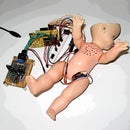Introduction: IR Receiver for Infrared Capture
Build a serial infrared receiver to control your computer via remote and capture IR signals.
Step 1: The Components
The first requirement is a serial port (RS-232). These guys are fairly outdated so if you don't have one but have a desktop then you can add one for around $5 (or more for a newer interface). And if you're into this kind of thing then you might as well add a parallel port too. There are a ton of circuits out there for the pair, which are more affordable and easier to source parts for than their modern USB replacements. If you're on a laptop then PCMCIA might be an option. Don't waste your time with a USB to serial adapter because it's not gonna work. If none of the above look like they'll work for you then stop reading and check out the USB IR Toy instead.
Ok, now that we have that out of the way let's look at the electronic components.
Ok, now that we have that out of the way let's look at the electronic components.
- A DB-9 hood (technically DE-9 but who cares) and female solder cup serial connector. These components are optional for the true hacker (but still recommended) since you can stick the components directly into the serial port if you're really anxious or cash strapped.
- An IR receiver module. 38kHz is the most common frequency in the U.S. but it will vary per country and device. These things are actually pretty cool since they handle a lot of compex filtering in a tiny package.
- A 78L05 voltage regulator. There are plenty of other options to get 5 volts but this is the best package when trying to stuff everything into a cramped enclosure.
- A few passive components that you hopefully have on hand, including a 4.7uf electrolytic capacitor, a 4.7k ohm resistor, and a 1N4148 diode.
- A few female jumper wires to make the receiver interchangeable. This also allows the device to be used as a 1-bit logic analyzer. Again, optional.
Step 2: Assembly
Follow the photos and schematic to assemble the receiver.
Step 3: Using the Receiver
You can use the receiver to control your computer with just about any IR remote control. My goal was to capture the signals to decode them (that project will be the next instructable). Both tasks can be acheived with LIRC, which despite the name is both Windows and Linux compatible.
I used the bundled xmode2 program for the capture in the screenshot above but it's only available for Linux. Windows has the text only mode2 though. Rather than duplicate existing instructions for setting up LIRC I'm just going to point you to the site I used for Linux and Windows.
I used the bundled xmode2 program for the capture in the screenshot above but it's only available for Linux. Windows has the text only mode2 though. Rather than duplicate existing instructions for setting up LIRC I'm just going to point you to the site I used for Linux and Windows.




